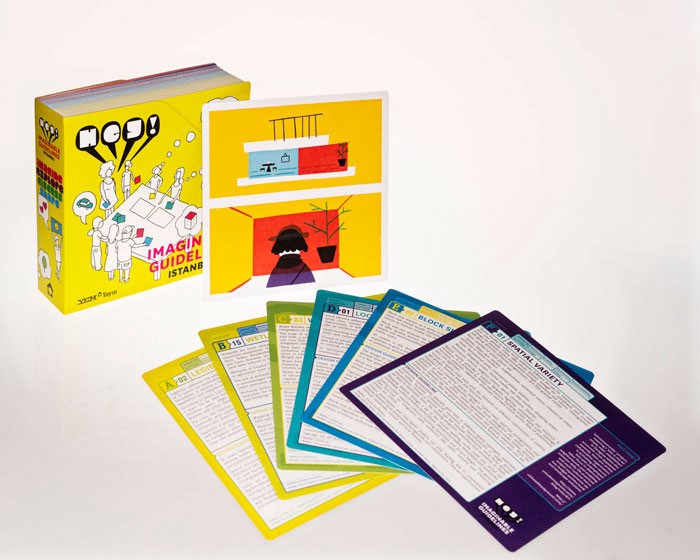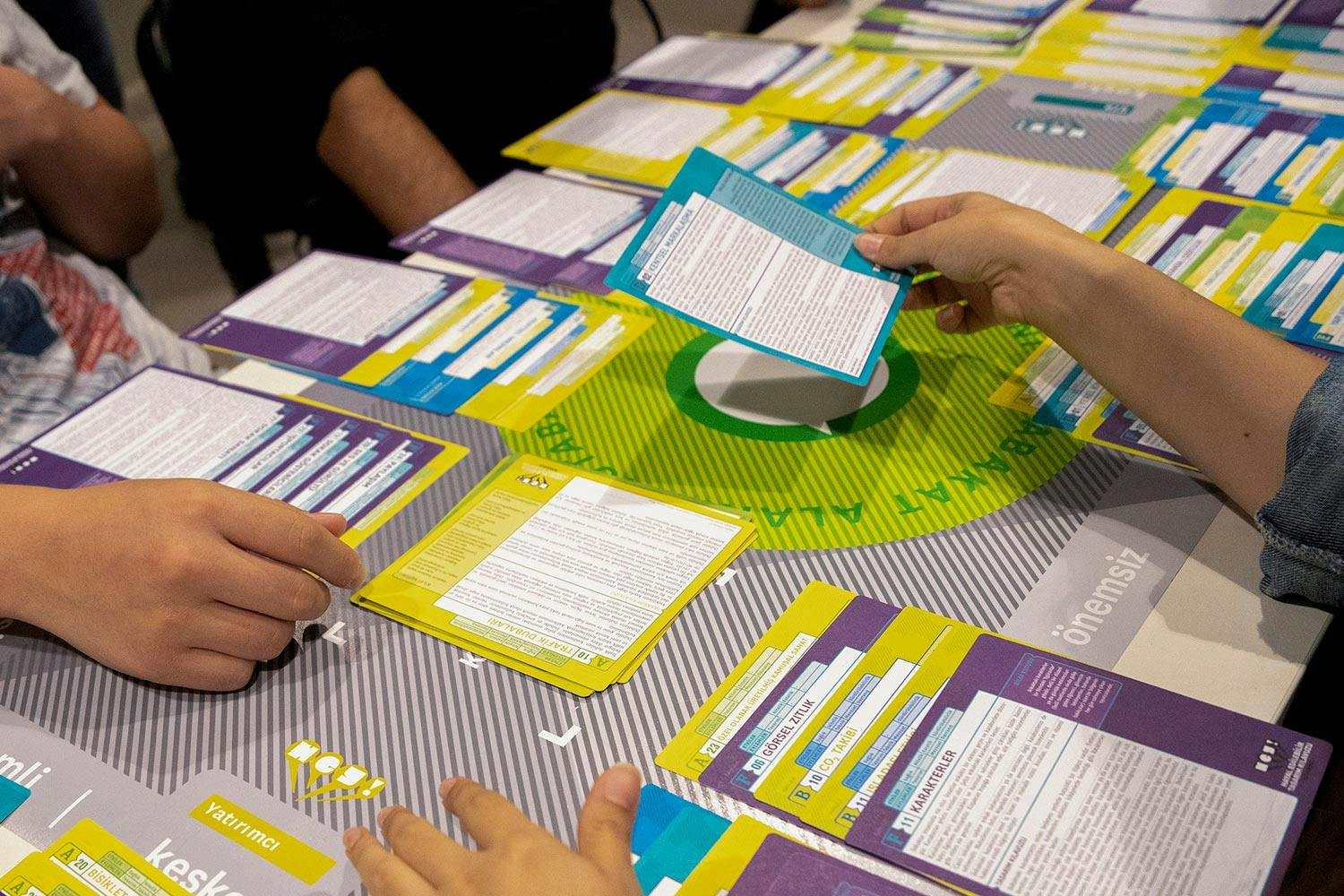How a Card Game Could Improve Urban Planning
An Istanbul architect has created a role-playing game so citizens can help design their cities.
Can a role-playing card game engage citizens in local planning? Istanbul architect Alexis Şanal thinks so.
What would it look like if ordinary citizens helped design their cities? For Istanbul-based architect Alexis Şanal, it looks like people sitting around playing cards.
Şanal’s brainchild, Hey! Imaginable Guidelines, is a sophisticated city-design tool masquerading as a role-playing card game. Şanal, who was born in Los Angeles and studied architecture at MIT, conceived the game five years ago after Istanbul’s Gezi Park protests: Demonstrations against turning a public green space into a mall were violently quashed by the government. Şanal then set out to address citizen disempowerment and improve Istanbul’s design culture in a whimsical way.
The game was released in November 2018. Since then, residents of Turkish seaside town Ayvalık have used the cards to create a design brief for a park. In Istanbul’s Beşiktaş district, locals are using Hey! to plan a public youth space. Internationally, groups in Beirut, Lisbon, and Sydney are testing the game for community projects this year, while a group in Jeddah is translating them into Arabic. Şanal hopes to eventually publish the game online in a format anyone can download and customize.
Şanal conceived the game after Istanbul’s Gezi Park protests were violently quashed by the government.
Games typically take place during two-hour workshops — so far, these have included design practitioners, NGOs, and student groups — and focus on predetermined urban design challenges. Successful play results in guidelines for urban planning based on the consensus of the players.
Can’t quite picture it? Neither could I. “People really can’t understand how it works,” says Şanal. “Everybody who plays it has the exact opposite experience.”
Game on
I meet Şanal for a game at her offices in Arnavutköy, an eclectic neighborhood facing the Bosphorus strait. Ottoman mansions, a trendy brunch spot, and the spire of a Greek Orthodox church are visible from the window.
Typically, games are played with four to eight players, ideally at events with up to 12 tables going at once. But, today, it’s just the two of us. Our design challenge is to figure out how to improve the corner outside the window. We adopt roles. I’m the middle-aged male owner of the next-door nalbur, a tiny, cave-like hardware store. Şanal is both an octogenarian resident in a second-floor walk-up and a design expert.

Each Hey! card explains an urban planning concept and illustrates it with an image by a local artist.
She passes out cards from the original deck, which is Istanbul-specific — decks for other cities are in the works — and includes 101 cards in six color-coded categories. Each card defines one topic, with a “design guideline” describing its best-practice application on one side and an image by a local artist on the other. Topics range from physical objects like “Curbs” or “Street Furniture” to complex concepts like “Urban Porosity,” which, according to the card, has to do with how permeable boundaries are between public, semi-public, and private spaces. Porous environments give people opportunities to interact.
We sort our cards into “not important,” “important,” and “wishful” piles based on our roles. Then, we explain “not important” choices to one another. We discard a topic if all players agree it’s irrelevant. If someone disagrees, they can take the card and lobby for it later. When I contend “Light Pollution” is unimportant because my shop closes before streetlights go on, Şanal — as the octogenarian — takes the card, saying bright lights “will blind me at night.” Next, I discard “Urban Porosity” because I don’t understand it. Şanal, now role-playing the expert, agrees it’s irrelevant to improving our corner. “We already have it with the church… and all the shops,” she explains.
Cards and role-play create emotional distance between players and hot-button topics, challenging participants to consider the issue from someone else’s perspective.
“Important” and “wishful” cards are handled similarly to “not important” ones, but players debate their importance to the game’s design problem. Eventually, the group divides the cards into “important” and “wishful” stacks, which are used to create two sets of guidelines: a “design brief” and “what everyone wishes could happen,” explains Şanal. “If you have a really good design team, you can achieve both.”
Rules of engagement
As we play, I see how Hey! could improve urban planning. Physical cards and role-play create emotional distance between players and hot-button topics, while challenging participants to consider the issue from someone else’s perspective. The game aims to ensure everyone feels heard by giving each player a chance to speak and listen before debate.
The cards’ content — most of which was crowdsourced from experts, artists, and citizens — gives players a vocabulary for discussing urban design, as well as a way to show city planners and decision-makers what issues matter to the public. Şanal’s partner, Murat Şanal, joins us after our game and notes that, after one or two sessions, players could “talk to the mayor” about city design. That hasn’t happened in Istanbul yet, but, at the time of writing, Alexis Şanal said residents who participated in the Ayvalık game planned to approach their mayor when they were further along in the design process.
Power to the people
The game’s fun role-playing and pretty packaging mask its serious goal of empowering ordinary citizens to reimagine and help shape public space. This contrasts with the hierarchical decision-making and polarized politics that often frustrate urban planning efforts.
But Hey! is also Şanal’s love letter to Istanbul, where residents resourcefully adapt streets to solve local challenges. “Some amazing innovation and urban solutions have arisen,” says Şanal in an email. She highlights pazar — weekly street markets with affordable, high-quality food — and dolmuş, shared taxis that operate like mini-buses and help many residents get around.
Hey! is Şanal’s love letter to Istanbul, where residents resourcefully adapt streets to solve local challenges.
Şanal also mentions gecekondu, buildings constructed overnight by rural migrants in Istanbul from the mid-‘40s to the mid-‘80s. Thanks to a legal loophole, the homes couldn’t be demolished if authorities didn’t notice them before dawn.
“Istanbul adapts itself to its period,” Şanal says fondly. “That’s how it’s lasted. I never would have made [Hey!] if I weren’t in Istanbul.”
Print Issue: Summer/Fall 2019
Print Title: Playing to Win at Urban Planning
